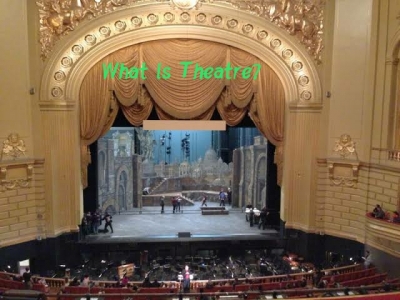
THEATRE
Theatre has its origins in Ancient Greece, where performances included singing and dancing as well as acting. In medieval times, plays were based on religious stories and were staged on large wagons in public places. It was not until the 17th century that theatres were built with a raised, framed platform, separating the audience from the stage by a curtain. Today, modern theatres provide the setting for performances of all kinds, from plays and pantomimes to opera and ballet.
PROSCENIUM
The decorated arch that divides the stage from the audience is known as the proscenium. It acts as a picture frame for the performance on stage. This type of arch was invented in Italy in 1618, although many modern theatres now have an open stage without a curtain.
CURTAIN
Made from heavy cloth, such as velvet, the curtain screens the stage from the audience while the stagehands are changing the scenery. The flameproof safety curtain prevents fire from spreading from the stage to the rest of the theatre.
BOX
The auditorium, where the audience sits, is made up of private boxes, tiered seats called the stalls, the dress circle, and the upper circle. Private boxes contain the most expensive seats and usually have the closest view of the stage.
WINGS
The offstage areas on each side of the curtain are called the wings. Concealed by the proscenium, the actors wait in the wings before they make their entrance on stage.
COSTUMES
The actors’ costumes are the responsibility of the wardrobe department. The wardrobe manager researches, designs, and looks after the costumes and helps the actors change outfits between scenes.
ORCHESTRA
Beneath the front of the stage is the orchestra pit, where the musicians and sound technicians sit. The conductor stands facing the stage to coordinate the music in time with the actions of the singers, dancers, and actors.
ACTORS
The success of a theatrical performance often depends on the skills of the actors, who use facial expressions, tone of voice, and gestures to make the audience believe what is happening on stage. The first recorded actor was a Greek poet called Thespis who was writing and acting out his own plays in the 6th century BCE.
SCENERY
Set designers use scenery to create atmosphere, set the location of the story, and give the illusion of distance and space on stage. Above the stage is a “fly” space in which scenery and equipment hang. A complex system of pulleys hoists heavy pieces of scenery to and from the stage.
STAGE
In the theatre, the stage is the platform where the performance takes place. Traditionally, the stage is made from wooden boards and often contains a trap-door through which performers and scenery can be raised and lowered.
Picture Credit : Google




